The Dell XPS 13 (9300) Review: Return of the King
by Brett Howse on July 16, 2020 10:00 AM ESTSystem Performance
When we reviewed the XPS 13 2-in-1 back in November, it was the first device we had tested which featured the new 10 nm Intel Ice Lake platform. At that time, Dell had also recently refreshed the XPS 13, but had outfitted it with the older 14 nm Comet Lake platform. For the all-new XPS 13, Dell has now brought parity to their lineup with Ice Lake here as well, with the improvements that platform brings, especially to the graphics side.
Dell offers three processor options. The least-expensive offering is the Core i3-1005G1, the mid-tier outfitted with the Core i5-1035G1, and the top-tier offering the Core i7-1065G7. Our review unit features the Core i7 model, as Dell wanted to put its best foot forward.
On the memory side, Dell’s spec sheet shows a 4 GB base, although thankfully that is nowhere to be found on their Dell.com site, at least for the USA. Thanks to the move to LPDDR4X with Ice Lake, Dell now offers up to 32 GB of memory on the XPS 13. Storage is all PCIe x4 NVMe, with 256 GB as the base, and a 2 TB maximum.
To see how the XPS 13 performs, we have run it through our newly updated laptop suite. Please not that if a graph does not contain a specific older device, that means that the test has not been run on it. Since the laptops are returned to the manufacturer after review, we cannot do any regression testing for the most part. If you’d like to compare the XPS 13 to any other laptop we have tested, please refer to our Online Bench.
PCMark
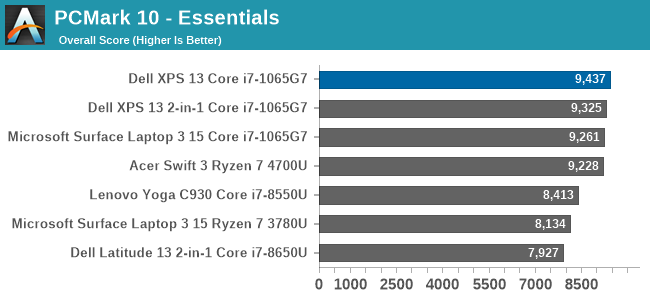
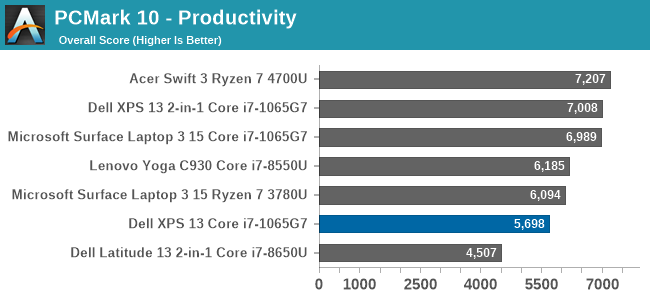
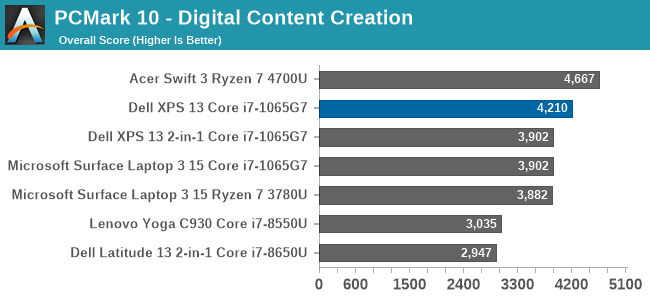
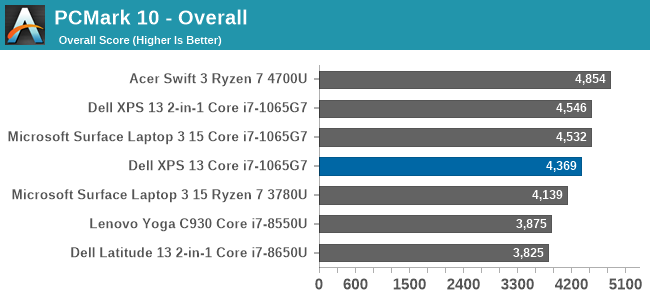
UL’s PCMark 10 is a whole-system benchmark, testing everything from CPU performance to app loading time. The Overall score consists of three categories, each featuring their own unique sub-tests. Overall the XPS 13 scored right in the same ballpark as other Ice Lake notebooks, although was slightly down in the Productivity tests, but slightly ahead in the other two.
Cinebench
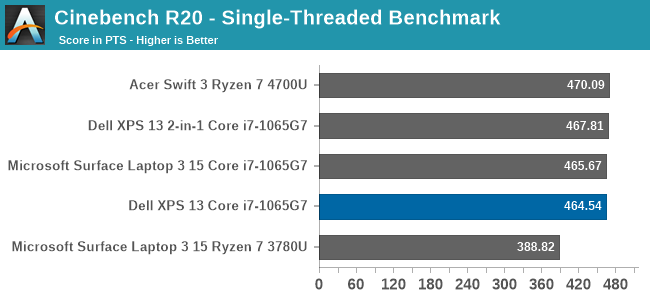
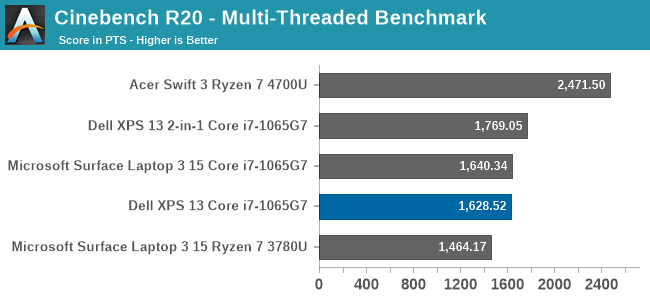
Cinebench, based on Maxon’s Cinema 4D rendering, allows tests of both single-threaded and multi-threaded runs, making it one of the more popular tests for overall computational performance. The XPS 13 does well compared to other Ice Lake equipped notebooks, although with AMD offering up to 8 cores in the same 15-Watt TDP, Intel falls behind in the multi-threaded run.
Handbrake
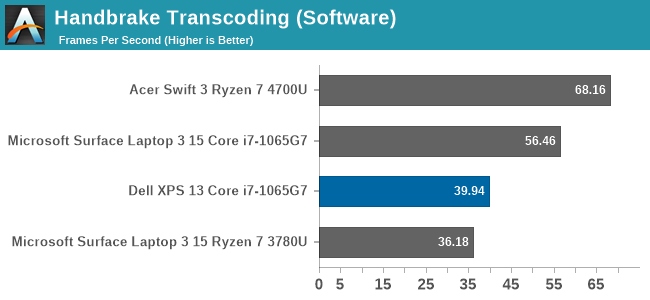
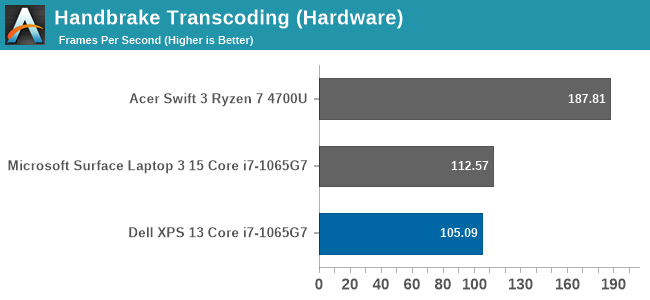
In our Handbrake encoding test, we transcode a 1080p movie to 720p using both software and hardware encoders. Software encoders utilize the CPU, and are generally the preferred method for optimal quality, whereas hardware encoders leverage the media blocks, which in this case is Intel’s QuickSync, for a much faster encode. As we will see more in the thermals section, Dell limits the XPS 13 to a 15-Watt TDP even in its maximum performance mode, where some other manufacturers will allow for higher than listed TDP, up to 20 Watts or so, and as such, the XPS 13 falls a bit behind other Ice Lake notebooks in this test which is TDP limited.
7-Zip


The popular file compression and decompression tool 7-Zip includes a built-in benchmark, and once again the XPS 13 slots right into where other Ice Lake notebooks fit.
Web Tests
Web performance is a function of not only the CPU performance, but also the browser’s scripting engine, and as such we have standardized on the Microsoft Edge browser. Microsoft has now transitioned their browser to the open-source Chromium project. Due to this, we have reset our web tests to use the new Chromium based Edge and taken the opportunity to decommission some of the older tests. We will now focus on Speedometer 2.0 and WebXPRT 3.
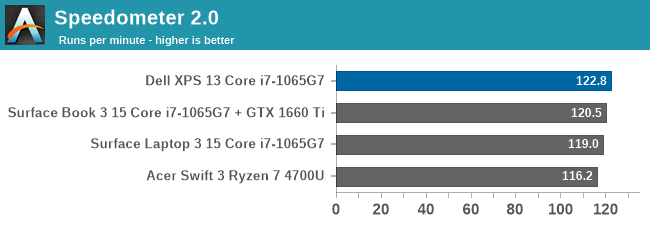
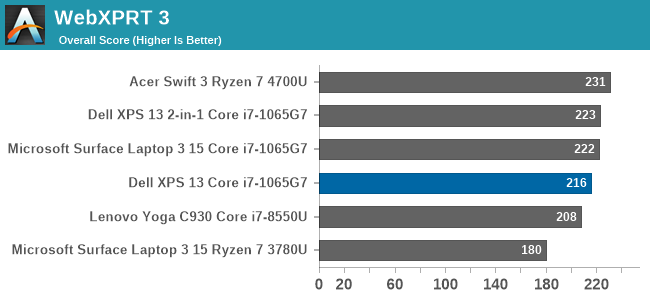
The XPS 13 again slots right in where you would expect for an i7-1065G7 based system.
Storage Performance
Dell offers from 256 GB to 2 TB of PCIe storage, and the review unit was outfitted with the Intel 600p 512 GB drive. We are transitioning to the PCMark 10 storage benchmark, which uses test traces of actual common workloads, such as booting Windows, and many of the Adobe applications, and as such should be a much better indicator of drive performance than just maximum transfer rates.
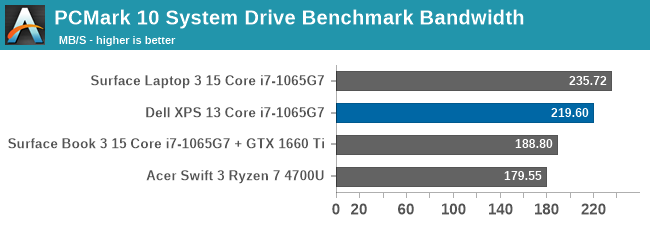
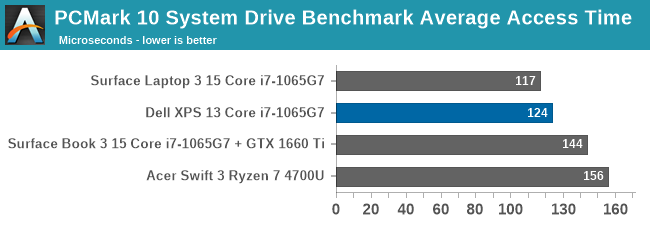

The Intel 600p performs quite well, with good access times and solid bandwidth. Surprisingly, it can’t quite match the excellent performance we saw from the SK Hynix 2230 form factor SSD in the Surface Laptop 3, but almost matches it.











224 Comments
View All Comments
Alistair - Thursday, July 16, 2020 - link
I own a XPS15 which had two main problems. Crappy Wifi chip (swap out for new Intel one, fixed) and bad cooling (can't fix, it is amazing how low my clock speeds went during gaming, buy a Ryzen 4700 Asus laptop and it is almost twice as fast because of thermals and better cooling). Mostly I want an XPS13 with AMD inside and I'll give it another shot. My $3000 XPS15 sits doing nothing, beaten by my $1500 Asus Ryzen 4000 laptop. G15.Shmee - Friday, July 17, 2020 - link
I looked at this, and I am very disappointed with anything soldered, means NON-upgradeable. Also lack of a separate GPU is also a problem. I am happy with my older, 15" MSI with the 7700HQ and GTX 1060. And upgradeable SATA 2.5" / m.2 drives, currently running an Adata SX8200 and a Samsung 850 Evo. I also have 2 SODIMM slots, can add another 16GB in if needed.Arbie - Friday, July 17, 2020 - link
My XPS13 had constant thermal problems that took months to "fix" - when I finally got rid of some Intel management software AND undervolted the CPU. At last the fan stopped cycling up and down just at idle, with the CPU at 70 degC. What a nightmare and so many hours wasted. Now I read in the comments here that undervolting is being disabled in Intel updates!I won't even consider another XPS13 unless it's AMD.
Spunjji - Friday, July 17, 2020 - link
I had this issue with my first-gen Infinity-Edge Broadwell XPS13. That combined with the "contrast boosting" display-dimming feature that couldn't be disabled made it useless for what I bought it for (mobile photo editing). I got rid of it in the end.Mikad - Friday, July 17, 2020 - link
Regarding the battery life & performance. It would be interesting to see how much you lose performance if you're running the laptop without the power cord.I have a somewhat bad feeling that the latest generation of laptops have a better battery life than the previous generations mainly because the laptops slow down their CPUs more than they used to.
If we take Surface Book 2 as an example (not a new laptop but still). The CPU automatically works with lower speeds when it is unplugged. AND it is not possible to get the full speed out from the machine, no matter how you change Windows' power settings.
Brett Howse - Friday, July 17, 2020 - link
That actually sounds like a good basis for an article. Windows 10 has added a lot of power management settings which can adjust the power levels of the CPU with just a slider. Can't promise anything right away but if I have time I'll look into this.zepi - Friday, July 17, 2020 - link
From what kind of USB-C chargers does this charge from? Does it charge from 9V 2A PD-charger or just complains that charger is not powerful enough? How about some 20V 2A or whatever else there might be?alexdi - Friday, July 17, 2020 - link
Lovely chassis. Not enough to make up for the wrong CPU and the lack of a 1600p screen. I don’t want battery-sucking 4K in a 13” laptop, but I also don’t want to see pixels on my small fonts.TEAMSWITCHER - Friday, July 17, 2020 - link
There is a big problem with these devices.. The focus on thin bezels has had a negative impact on the palm rest area. It's so tiny now that the typing experience isn't very good. I suppose if you don't use it that much - it's bearable. But for heavy keyboarders ... like programmers ... I would recommend the Dell XPS 15 or 16" MacBook Pro instead. They only costs a few dollars more, but deliver a much better experience all around.Spunjji - Friday, July 17, 2020 - link
The USP of the Dell was always that it's a 13" display in a 12"-sized chassis, so the palm-rest should really be judged as such. There are a few 14"-in-13"-chassis devices out there (LG Gram 14, Matebook D, Swift 5 14) if you need more room.